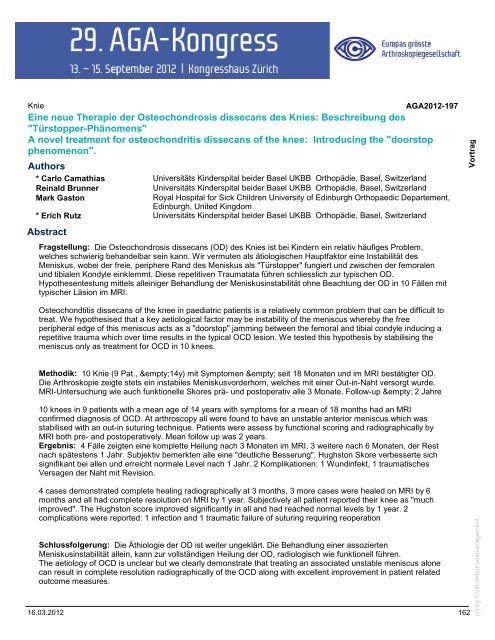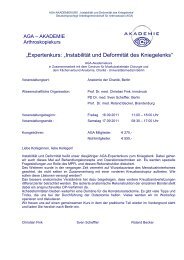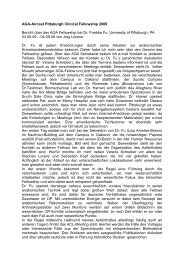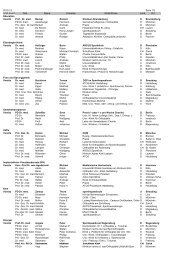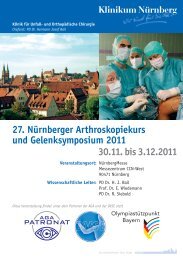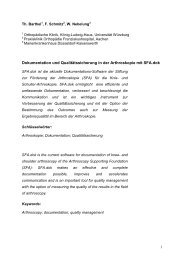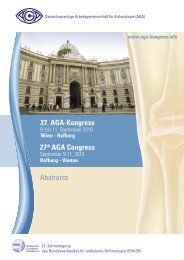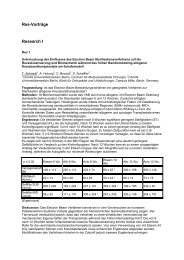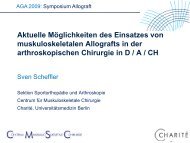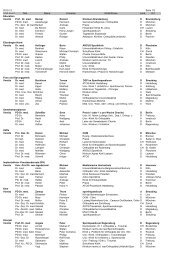als PDF - AGA
als PDF - AGA
als PDF - AGA
Sie wollen auch ein ePaper? Erhöhen Sie die Reichweite Ihrer Titel.
YUMPU macht aus Druck-PDFs automatisch weboptimierte ePaper, die Google liebt.
Knie<br />
<strong>AGA</strong>2012-197<br />
Eine neue Therapie der Osteochondrosis dissecans des Knies: Beschreibung des<br />
"Türstopper-Phänomens"<br />
A novel treatment for osteochondritis dissecans of the knee: Introducing the "doorstop<br />
phenomenon".<br />
Authors<br />
* Carlo Camathias Universitäts Kinderspital beider Basel UKBB Orthopädie, Basel, Switzerland<br />
Reinald Brunner Universitäts Kinderspital beider Basel UKBB Orthopädie, Basel, Switzerland<br />
Mark Gaston Royal Hospital for Sick Children University of Edinburgh Orthopaedic Departement,<br />
Edinburgh, United Kingdom<br />
* Erich Rutz Universitäts Kinderspital beider Basel UKBB Orthopädie, Basel, Switzerland<br />
Abstract<br />
Fragstellung: Die Osteochondrosis dissecans (OD) des Knies ist bei Kindern ein relativ häufiges Problem,<br />
welches schwierig behandelbar sein kann. Wir vermuten <strong>als</strong> ätiologischen Hauptfaktor eine Instabilität des<br />
Meniskus, wobei der freie, periphere Rand des Meniskus <strong>als</strong> "Türstopper" fungiert und zwischen der femoralen<br />
und tibialen Kondyle einklemmt. Diese repetitiven Traumatata führen schliesslich zur typischen OD.<br />
Hypothesentestung mittels alleiniger Behandlung der Meniskusinstabilität ohne Beachtung der OD in 10 Fällen mit<br />
typischer Läsion im MRI.<br />
Osteochondtitis dissecans of the knee in paediatric patients is a relatively common problem that can be difficult to<br />
treat. We hypothesised that a key aetiological factor may be instability of the meniscus whereby the free<br />
peripheral edge of this meniscus acts as a "doorstop" jamming between the femoral and tibial condyle inducing a<br />
repetitive trauma which over time results in the typical OCD lesion. We tested this hypothesis by stabilising the<br />
meniscus only as treatment for OCD in 10 knees.<br />
Methodik: 10 Knie (9 Pat., ∅14y) mit Symptomen ∅ seit 18 Monaten und im MRI bestätigter OD.<br />
Die Arthroskopie zeigte stets ein instabiles Meniskusvorderhorn, welches mit einer Out-in-Naht versorgt wurde.<br />
MRI-Untersuchung wie auch funktionelle Skores prä- und postoperativ alle 3 Monate. Follow-up ∅ 2 Jahre<br />
10 knees in 9 patients with a mean age of 14 years with symptoms for a mean of 18 months had an MRI<br />
confirmed diagnosis of OCD. At arthroscopy all were found to have an unstable anterior meniscus which was<br />
stabilised with an out-in suturing technique. Patients were assess by functional scoring and radiographically by<br />
MRI both pre- and postoperatively. Mean follow up was 2 years.<br />
Ergebnis: 4 Fälle zeigten eine komplette Heilung nach 3 Monaten im MRI, 3 weitere nach 6 Monaten, der Rest<br />
nach spätestens 1 Jahr. Subjektiv bemerkten alle eine "deutliche Besserung". Hughston Skore verbesserte sich<br />
signifikant bei allen und erreicht normale Level nach 1 Jahr. 2 Komplikationen: 1 Wundinfekt, 1 traumatisches<br />
Versagen der Naht mit Revision.<br />
4 cases demonstrated complete healing radiographically at 3 months, 3 more cases were healed on MRI by 6<br />
months and all had complete resolution on MRI by 1 year. Subjectively all patient reported their knee as "much<br />
improved". The Hughston score improved significantly in all and had reached normal levels by 1 year. 2<br />
complications were reported: 1 infection and 1 traumatic failure of suturing requiring reoperation<br />
Schlussfolgerung: Die Äthiologie der OD ist weiter ungeklärt. Die Behandlung einer assozierten<br />
Meniskusinstabilität allein, kann zur vollständigen Heilung der OD, radiologisch wie funktionell führen.<br />
The aetiology of OCD is unclear but we clearly demonstrate that treating an associated unstable meniscus alone<br />
can result in complete resolution radiographically of the OCD along with excellent improvement in patient related<br />
outcome measures.<br />
16.03.2012 162<br />
Vortrag<br />
(c) by CVS://Abstractmanagement


